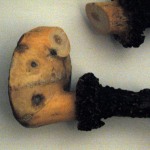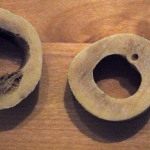You are currently browsing the category archive for the ‘making’ category.
Category Archive
KONFRONTATION, pt. 2 [bones and antlers]
April 22, 2009 in art, Australian art, craft, design, design concepts, jewellery/metalwork, making, my work, Personal | Tags: antlers, art, Australia, australian artists, Australian design, Australian designers, bone, bone carving, carving, confrontation, contemporary art, contemporary jewellery, craft, danyka, Danyka van Buuren, design, design concepts, konfrontation | Leave a comment
KONFRONTATION, pt. 1 details the background to the project.
I have begun exploring bone and horn as possible materials for my project.
I purchased a piece of hunting memorabilia – a trophy mount of the antlers of a Roe deer (complete with sawn-off skull fragment) – from the local fleamarket.
After a very confronting trip to the butcher, I purchased some cheap bony cuts, including sliced beef shinbone and pig feet. More confronting was having to handle the pieces themselves (having not touched meat for around six years, it is a very alien concept to me…) and extracting the usable material from the cuts.
First, the pieces are simmered for a long while in water with a bit of detergent. This helps break down the fat, marrow and remaining tissue. For me, the smell was horrendous. It was rich and heavy, and loaded with the artificial citrus of the soap didn’t help. It smelled like an old kitchen. In fact, the whole 32sqm of my flat smells like an old kitchen, despite all the windows being open, and copious amounts of air freshener. A part of me keeps telling me I shouldn’t deny myself the full extent of the experience, but my nausea dictates otherwise…
Scraping off the excess flesh and removing the marrow was also less-than-enjoyable… The marrow became this sloppy, gelatinous mass, which was to be pushed out with a brave finger. Fortunately, it revealed on one piece a stunning area of lacy, porous bone. Less than ideal for traditional carving, perhaps — but something I’d like to exploit.
After boiling away the tissues, the bones are to be sunned for at least a few days. This tutorial on bone preparation details the rest of the process, which I am yet to complete. This succinct supply and prep list is also really helpful. Luckily, most of the tools can be found on a jeweller’s bench, and I will happily improvise where necessary.
Luckily, I also obtained a small piece of pre-prepared cattle bone to play with. It is a beautiful material, dense and chalky, with subtleties of texture and colour throughout. It polishes beautifully, too. My preference is to use a nail bufffer (the dispoable kind, usually with two emery surfaces and two buffing surfaces adhered to a cushioned board), which is what I often use on my melamine pieces, after initial emery (anything up to 600).
The smell released from the bone from carving is also pungent (though not as much as the boiling, fortunately). It has the distinct smell of umami – the proteinous aroma present in meat, mushrooms and human semen…
I’ve included some pictures of this intitial research below, but I should warn you in advance – it’s not so nice to look at. But then, we’re all part of the system, right?
{N.B. This post has been edited for clarity.}
KONFRONTATION, pt. 1 [introduction]
April 22, 2009 in adventures, art, Australian art, craft, design concepts, jewellery/metalwork, making, my work, Personal, resources | Tags: antlers, australian artists, Australian design, bone carving, carving, confrontation, contemporary craft, contemporary jewellery, craft, danyka, Danyka van Buuren, deer, Herman Hermsen, jewellery, konfrontation, meat, subversive craft | Leave a comment
“Konfrontation” is the name of one class I am taking, led by Dutch designer/maker Herman Hermsen.
The aim of the project is to create one or a series of objects (which may or may not be wearable) which in some way deal with the concept of confrontation. This could be a confrontation between viewer-and-object, viewer-and-wearer, maker-and-object, or myriad other combinations.
My response to this brief is to create a series of wearables which deals with our individual capacity for violence and the acceptance (or, for the most part, inacceptance) of this very human attribute. It is confronting and difficult for the average person to accept that they could willingly kill, physically harm or cause pain to another sentient being (be it animal or another human). However, we are faced with this prospect every day. Humans eat and use animal products; and wilfully exploit and harm one another.
So how do we deal with these ever-present threats to our composure?
For the most part, we don’t kill our own meat, skin our own hides our gut our own fish. Our animals come from factories — plastic wrapped, pre-minced, de-boned, tanned, canned, safe and inert. We are not the slaughterers, not part of the violence. Behind doors, from field to supermarket to plate. Through avoidance comes transcendence, apparently.
And likewise, when faced with the prospect of human-to-human violence, we document it with morbid curiosity — film, television, hi-res, full-colour glamour-horror — we recoil in disgust, and are compelled to disgust; to dissociate ourselves from the violence; to avoid admitting our own capacity for violence. Our humanness. So creates necessity for such spectacle. So we can constantly recoil. So we can remind ourselves of how much we are “not that”.
Enjoying our avoidance over the 6 o’clock news while eating a steak dinner.
But I cannot deny myself that I do not have this capacity. In fact, I want to embrace it. The beautiful thing about being human, having free will, is our ability to make choices. Knowledge is bliss. I am not advocating violence, by any means. Suffering is the consequence of violence, and suffering is terrible. We must remember, we all have the capacity to suffer.
The thing I am most interested in are these ‘safety mechanisms’ we have in place, in order to somehow deny our own capacity for violence. Constructs to protect our selfhood, our identity.
My intent is not to create an overtly political or evangelical statement, but rather an enlightening one. I want to create beautiful objects with the remnants of violence. To explore the tension between self-identity, beauty and violence. I strongly feel that the statement is far more powerful if the audience draws conclusion of their own accord, rather than being smacked in the face with it. The last thing contemporary art needs is another misanthrope.
More importantly, I will confront myself within the process of making these works. Having been a vegan for five years (which I am no longer; as of December 2007 I have been a vegetarian) I have begun to accept the nature of human experience and my own capacity for violence, my own “humanness”. So I am willingly partaking in the cycle, buying animal parts, preparing and using these materials, these remnants of violence.
Now, onto the background research:
The film Unser Täglich Brot (Our Daily Bread) demonstrates the concept I want to explore. It is an un-narrated documentary constructed solely out of footage from inside food-production factories, in the form of a series of rhythmic, composed vignettes. There is no overt political, moralistic or evangelistic overtones, rather the hypnotic effect of repetitive production lines is what is so compelling.
The next instalment will document practical research – materials, techniques and aesthetics.
{N.B. this post has been edited for clarity.}

















Recent Comments